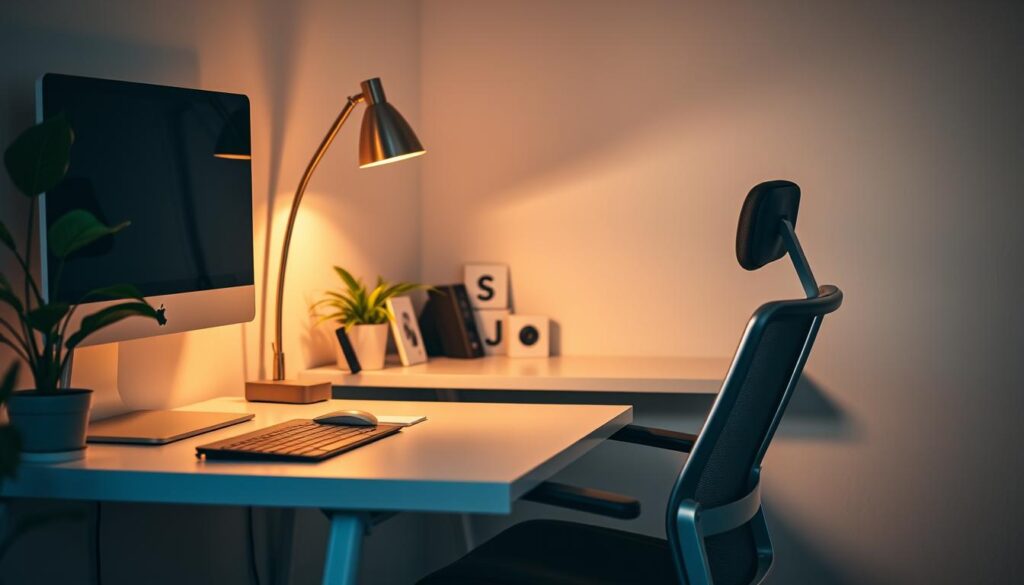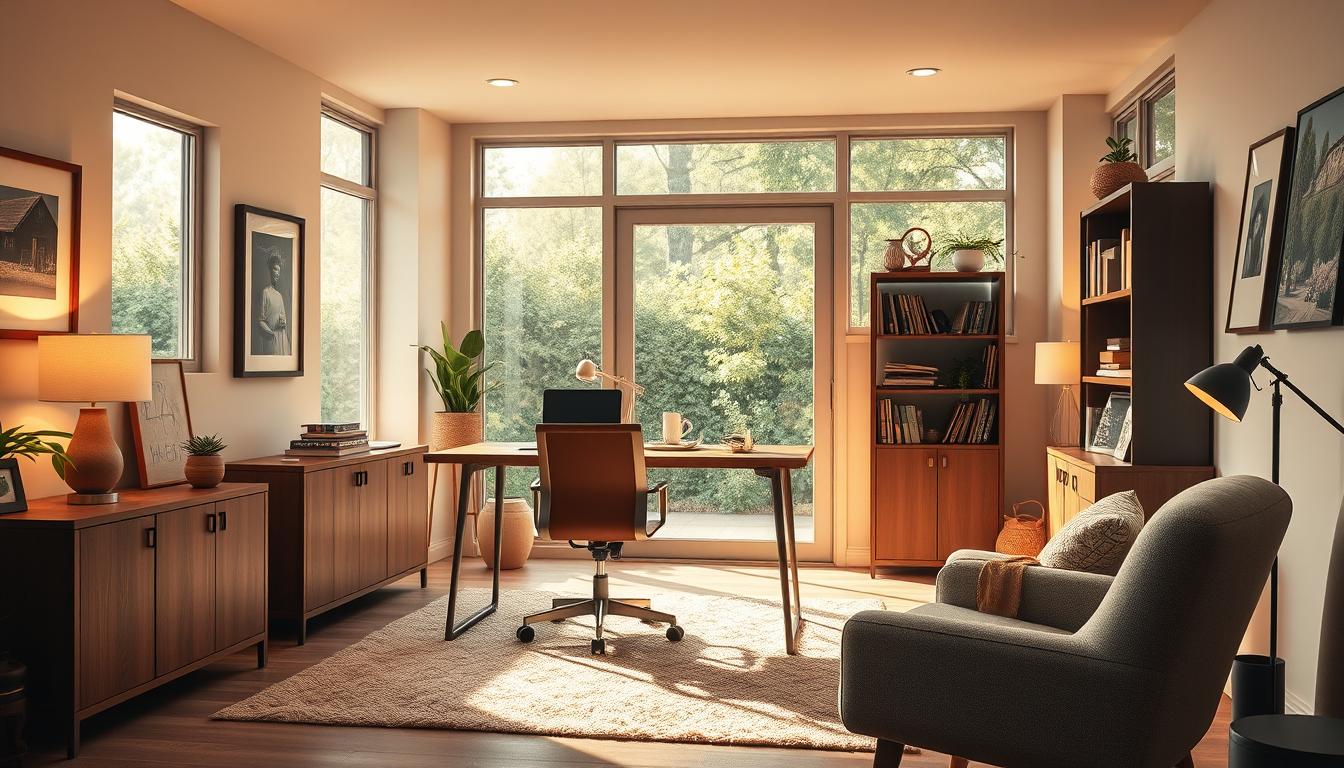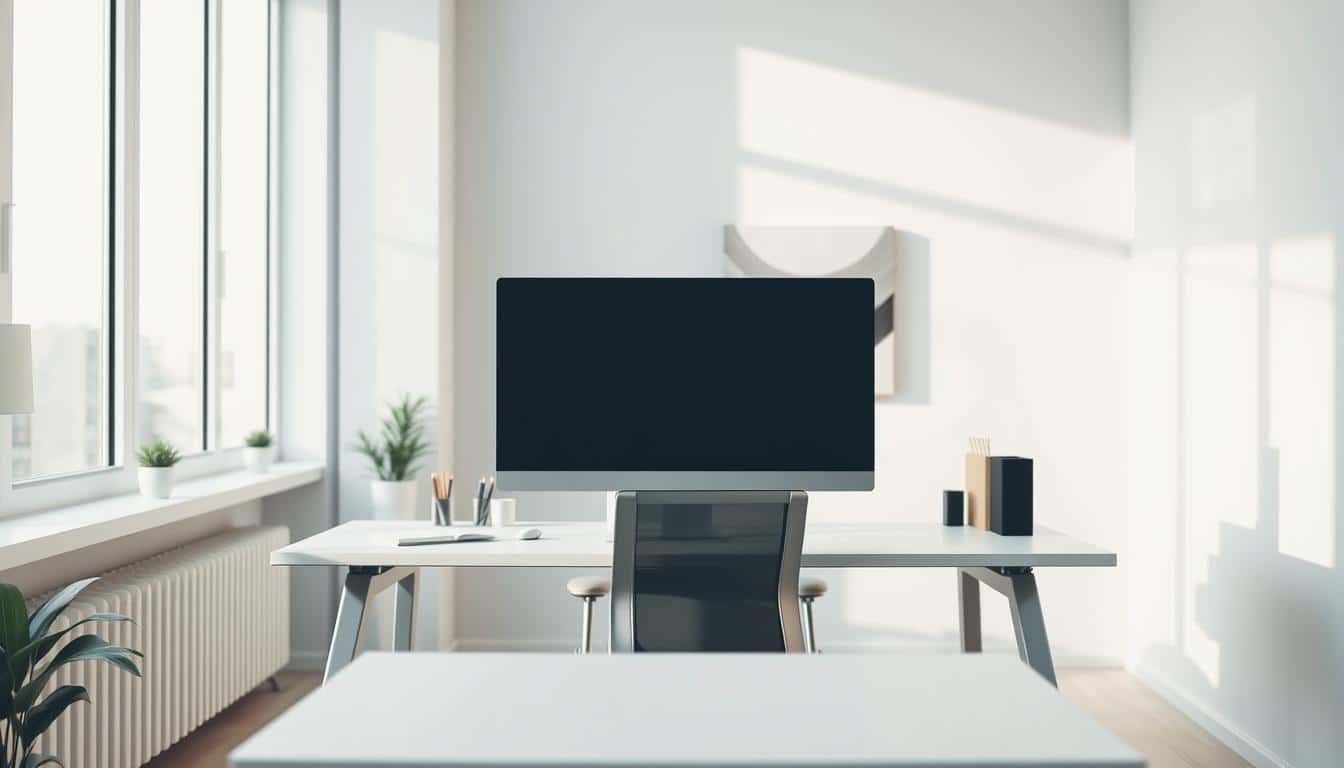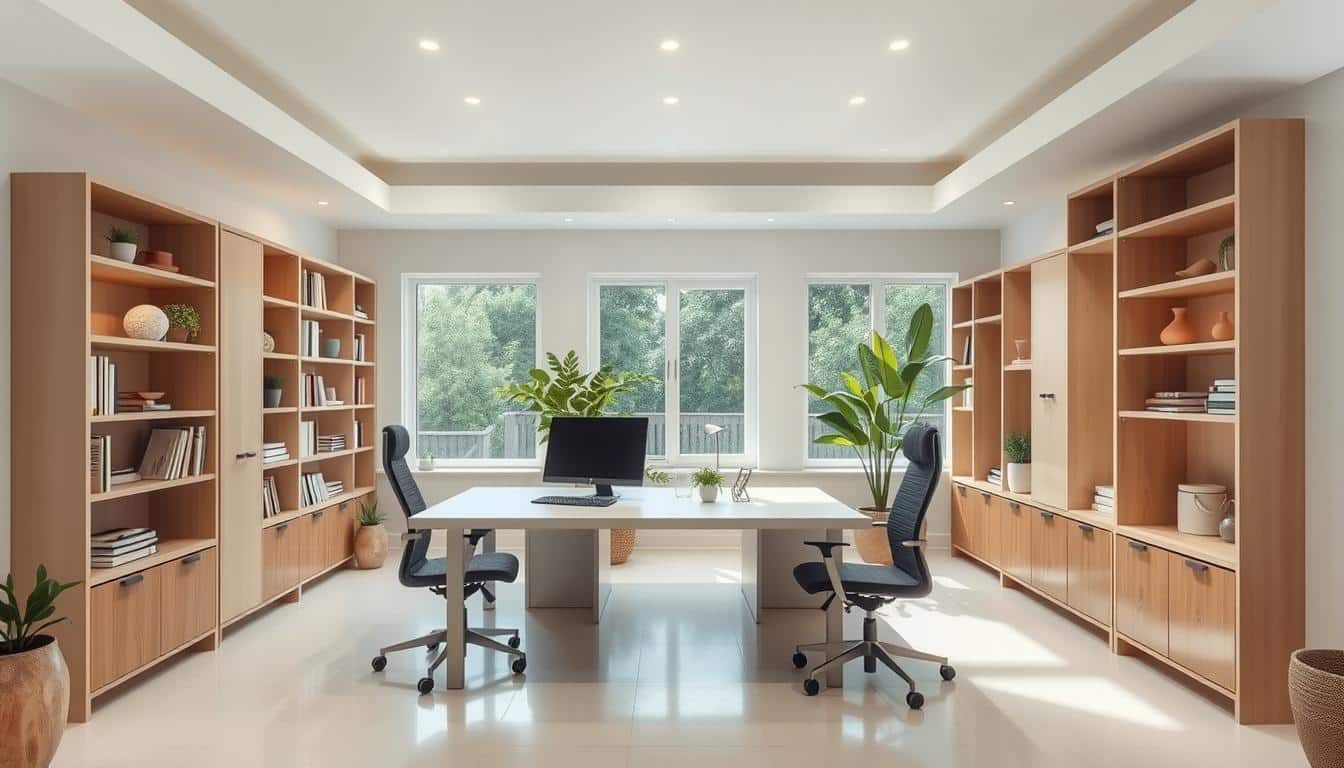Today’s work life moves fast, so knowing how to make your workstation comfy is key for productivity and health. An ergonomic workspace boosts work efficiency and cuts down stress. It’s not just a passing fad.
By tuning your desk setup right, with a good chair, a well-arranged desk, and your monitor in the right spot, you can avoid some health problems. This makes work more comfortable and helps you do better in your job.
The Importance of Workstation Comfort
Workstation comfort is key to boosting overall productivity. It ensures employees can focus on work without getting sidetracked. Studies show that comfortable workers are more focused and produce better quality work.
Investing in ergonomic furniture supports natural body posture. This leads to greater job satisfaction and performance.
Enhancing Productivity Through Comfort
An environment that offers comfort boosts productivity. Workers in ergonomic spaces face less discomfort. This means they can concentrate better on their tasks.
- Adjustable desks that allow for sitting and standing options.
- Chairs with excellent lumbar support to maintain proper posture.
- Organized spaces that minimize clutter and distractions.
Health Benefits of an Ergonomic Workspace
An ergonomic workstation not only improves productivity but also protects health. Incorrect setups can cause neck and back pain or repetitive strain injuries. A well-planned ergonomic design helps workers avoid these issues.
- Reduced physical discomfort during extended work hours.
- Lower risk of developing chronic conditions associated with poor posture.
- Increased morale and job loyalty due to a more supportive work environment.

Choosing the Right Chair for Your Workspace
Selecting a good chair for your workspace is key to feeling comfy and staying productive. The perfect chair gives great support and looks after your spine’s health.
Support for Your Spine
Ergonomic chairs support your spine’s natural shape. They lower the chance of back pain and help you sit right all day. It’s vital to have a chair with good lumbar support to keep your spine happy. Look for features that support your lower back, easing discomfort from sitting too long.
Adjusting Chair Height for Optimal Comfort
Being able to adjust your chair is crucial for your comfort. Your chair’s height should let you plant your feet firmly on the ground or a footrest. Your thighs should stay level with the floor to keep blood flowing and prevent your legs from getting tired.
If your chair has armrests, make sure you can adjust them. This lets your arms relax while keeping your elbows by your side. Such a setup helps your shoulders stay loose and boosts your overall health.
Desk Setup: Creating the Ideal Work Environment
A good desk setup is key for comfort and staying productive during long work hours. It not only makes for a better work atmosphere but also helps avoid body strain. By setting up your space correctly, you can improve your posture and overall well-being.
Ensuring Ample Legroom
Having enough space for your legs under the desk is important for staying comfortable all day. To get the best setup:
- Keep under your desk clear of clutter.
- Make sure there’s plenty of room for your legs to move.
- Use a footrest if your feet don’t touch the ground.
Adjusting Desk Height for Better Posture
It’s important to have your desk at the right height for good posture. You want your arms to be level while you type. If your desk doesn’t adjust, try these ideas:
- Raise your desk with blocks.
- Change your chair height to keep your wrists comfortable.
- Make sure your keyboard and mouse are within easy reach to avoid wrist pain.
Optimizing Monitor Positioning
Placing your monitor right can lessen eye strain and boost comfort at work. It’s key to adjust the monitor’s distance and height for better ergonomics and work performance.
The Proper Distance from the Screen
Keep the monitor around an arm’s length – at least 20 inches away – for comfort. This distance eases eye strain and makes viewing more natural. Adjusting its position regularly can keep you comfortable during long workdays.
Eye Level Alignment for Reducing Strain
Setting the top of your monitor at or slightly below eye level helps your neck relax. For those with bifocals or progressive lenses, dropping the monitor one to two inches improves viewing comfort. This right alignment reduces the discomfort from staring at the screen too long.
Organizing Your Keyboard and Mouse
Setting up your keyboard and mouse the right way is key to a comfy, efficient workspace. Put the keyboard in front of you so your wrists stay straight and shoulders feel loose. This keeps you from straining when you’re at it for a long time.
Positioning for Comfort and Efficiency
Make sure the mouse is on the same level as the keyboard to avoid lifting your wrist too much. This setup lets you move more freely and reach things easier. Try not to stretch or twist too much when reaching for them.
Using Wrist Rests to Prevent Injury
Adding wrist supports like wrist rests can really up your comfort game. They give a soft layer between your wrist and the desk and keep your wrists lined up just right. This cuts down on pressure and is key in dodging injuries from repeating the same motions, keeping you safe during those long work sessions.
Implementing Office Ergonomics in Your Workspace
Creating a better workspace means using office ergonomics. Ergonomics help improve comfort and productivity. By understanding ergonomic principles, companies can meet the needs of their workers. This leads to a healthier work environment. Making small changes can greatly improve workstations. This encourages workers to be more involved and healthy.
Understanding Ergonomic Principles
Ergonomic principles make the workplace better for each worker. They help reduce discomfort and lower the chance of getting hurt. Important parts include good posture, easy access to tools, and furniture that can be adjusted. When companies follow these ideas, they create a place where workers feel comfortable and focused.
Products to Enhance Ergonomics
It’s important to invest in ergonomic products for a healthy office. Some key items are:
- Height-adjustable desks for sitting or standing.
- Ergonomic chairs that support the spine well.
- Anti-fatigue mats for those who use standing desks.
Using these tools makes workstations better. It helps workers stay active and cuts down on health-related time off.
Creating a Clutter-Free Desk for Enhanced Focus
A clutter-free desk boosts focus and productivity. Decluttering makes the environment organized. This improves mood and efficiency. Having tools within reach cuts down distractions and boosts creativity.
Tools at Your Fingertips
Organizing tools is key for a tidy desk. Here are some tips:
- Use drawer organizers or desktop trays for easy access to pens, notepads, and other items.
- Incorporate cable management solutions to avoid tangling electronic cords.
- Keep personal items to a minimum for professionalism and a welcoming space.
The Benefit of a Clean Workspace
A neat desk is about more than looks. It lowers stress and improves focus. With no clutter, your mind can focus better. Let’s look at the benefits:
- It brings mental clarity and reduces visual distractions.
- It increases motivation by encouraging creativity.
- It helps in managing time better by keeping necessary tools handy.
Incorporating Nature into Your Workspace
Adding nature to your workspace makes it better and boosts well-being. Office plants make the space look nice. They help lower stress, which can make people more motivated. Using biophilic design makes offices feel more alive, helping with creativity and engagement.
The Psychological Benefits of Plants
Studies show that plants in the office have many benefits. They make workspaces calming, which lowers stress and raises productivity. People working around plants are happier and work better together.
Designing a Biophilic Workspace
Designing a biophilic workspace is more than adding plants. It’s about bringing in natural light, water, and organic materials. This creates a natural feel. Use big windows to let in lots of natural light. It’s good for the plants and makes people feel better and more focused. A well-thought-out space makes employees feel good and boosts creativity.
Conclusion
Improving the comfort of your workstation is key to getting more done and feeling better at work. You can make your workspace better for your body and mood by using good design. Things like comfy chairs, a well-organized desk, and plants are very important.
When you make your workspace better, everyone wins. Employees are happier and don’t miss work as much. Plus, work gets done faster and better. Making small changes can lead to big improvements for everyone at the company.
Spending time to improve your workspace is a smart move. It leads to better health and more work getting done. As more people realize how important this is, those who keep up will do well in their jobs.



